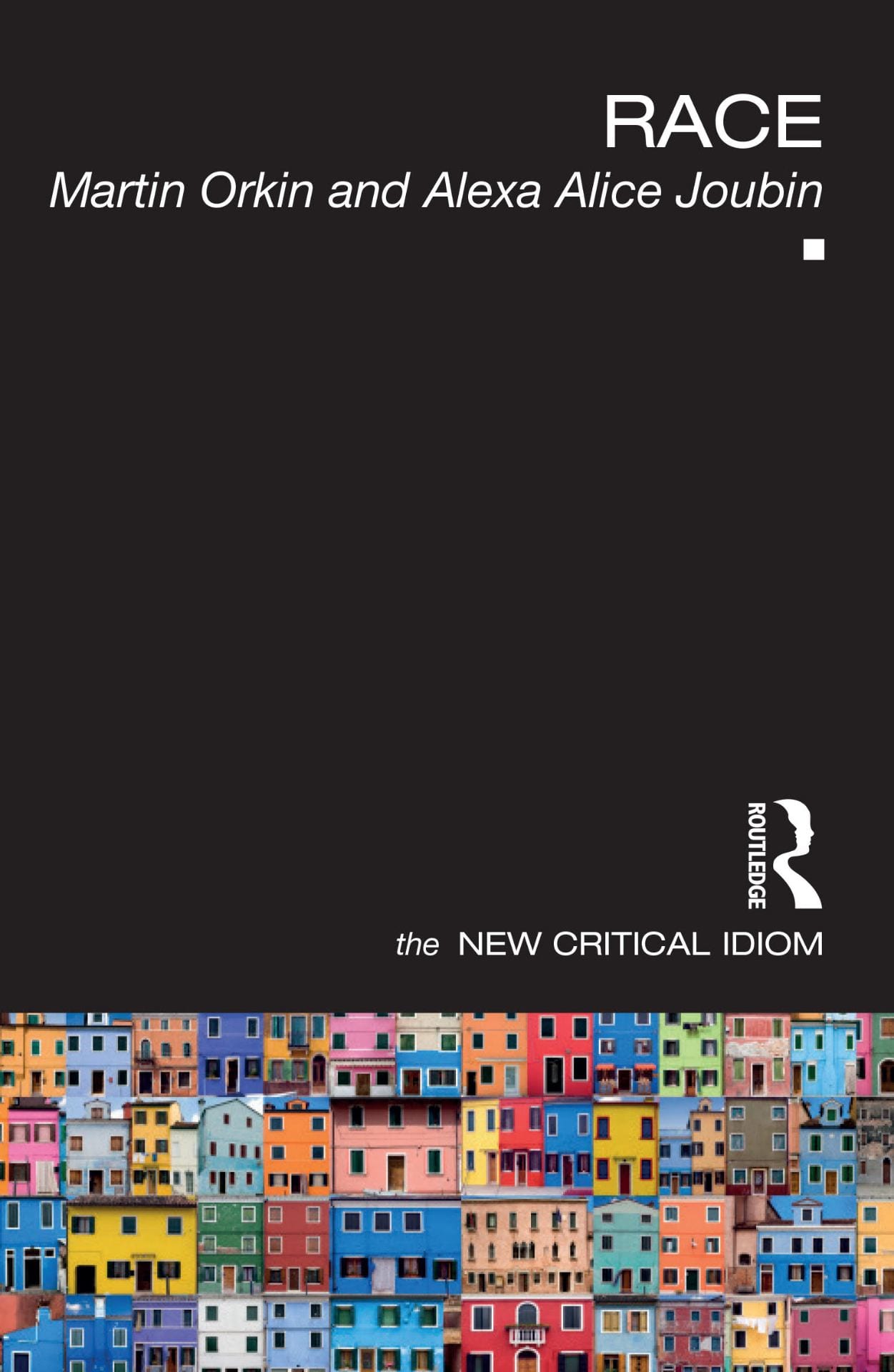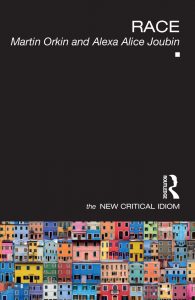MIT Global Shakespeares co-founder and co-editor Alexa Alice Joubin has published a new book, Race, with postcolonial theorist Martin Orkin. The book is part of Routledge’s New Critical Idiom series. The series emphasizes clarity, lively debate, and original and distinctive studies of important topics by leading scholars.
Read about the book launch on GW Today.
Race offers a compelling study of ideas related to race throughout history. Its breadth of coverage, both geographically and temporally, provides readers with an expansive, global understanding of the term from the classical period onwards:
- Intersections of Race and Gender
- Race and Social Theory Identity
- Ethnicity, and Immigration
- Whiteness
- Legislative and Judicial Markings of Difference
- Race in South Africa, Israel, East Asia, Asian America
- Blackness in a Global Context
- Race in the History of Science
- Critical Race Theory
The following is excerpted from chapter 5 of Race by Martin Orkin and Alexa Alice Joubin. New Critical idiom Series. London: Routledge, 2019, pp. 193-227. Full text available online
When confronted with the unknown, many societies tend to transfer observations of unfamiliar phenomena onto their mental map of what is already known. Race as a category is entangled with empirical knowledge, misinformation, and ideology, all of which seek to justify and sustain particular beliefs. Knowledge about otherness is socially constructed. Knowledge of race results from taxonomical observations made for colonial, medical, bureaucratic, or other purposes such as political movements.This knowledge is often articulated in the form of inaccurate stereotypes deriving from perceived behavioral patterns, political shorthand that condenses biological features such as skin color and other bodily characteristics, racialized cultural artifacts such as hip-hop or chopsticks that are associated with particular groups or cultures, and check boxes on government forms that require information that encode racial characteristics.
As is often the case, without contact with or the threat from other groups, there is generally no perceived need for self-definition. Is one born black, or does one become black? European observers associated red with American Indians’ skin color because of their war paint and because of the sun-screening substance they used to anoint themselves. American Indians became red when the need for distinction between the European settlers and the natives arose. In pre-modern China, peoples of many ethnicities and cultural origins “became” black in the Chinese consciousness. Increased cross-cultural contacts seemed to have only broadened the idea of blackness. Numerous peoples were given the label “black.” Initially the Nam-Viet peoples and Malayans, China’s Southeast Asian neighbors, were designated black in the Tang dynasty, but with China’s increased encounters with slaves from Africa (modern-day Somalia, Kenya, Tanzania) from the seventh to the seventeenth centuries, the “blacks” in Chinese consciousness expanded to include peoples from various parts of the world, including Bengali peoples of the Indian subcontinent, who were deemed different from the local population.
Epistemologies of race signify relationally, which means a group that suffers from discrimination can themselves discriminate against other groups based on any combination of the factors of race, class, gender, religion, and politics. Along similar lines, there is the phenomenon of what is sometimes called internal racism, or intra-group hatred, where a community has internalized its former colonizer’s outlook. In politically post-colonial but culturally colonial societies such as Singapore, where the state apparatus openly uses race as a category in its promotion of institutionalized multiculturalism, whites are typically placed above the local race in the social hierarchy while darker-skinned migrant workers are placed below.
As fundamentally personal forms of self-expression, arts and literature are a fertile area to explore the expressions of racialized experience.
Race and gender are interconnected categories. Similar to other categories of identity, racial difference is often imagined as an inversion of what are perceived to be gender norms. Ania Loomba points out that “patriarchal domination … provided a model for establishing racial hierarchies and colonial domination,” as evidenced in a number of once prevalent beliefs, such as the ideas that Jewish men menstruate, Egyptian women urinate standing up, and Muslim men engage in sodomy. In terms of the “yellow peril,” which we discussed earlier, the concept has intersected, in twentieth century United States with gender stereotypes: yellow fever. For example, punning on the disease of the same name, David Henry Hwang uses yellow fever in his play M. Butterfly(1988) to describe white men with a sexual fetish for East Asian women who are imagined to be subservient, dainty, and more feminine than their Western counterparts. In contemporary American media and popular discourse on dating, the term is used to identify and sometimes to critique the social phenomenon of white men exclusively preferring East Asian women.
The intersectionality of race, gender, and nation is articulated in the context of colonial India by E.M. Forster in his novel A Passage to India. Drawing on the author’s own trips to colonial India in 1912 and 1921, the novel offers both a critique and inadvertent affirmation of racial stereotypes of both Indians and the British colonizers. Even as Forster attempts to unravel the stereotypes of the “Orientals,” his novel is marked by broad generalizations about British and Indian sexuality and by its implicit acceptance of an Anglo-European epistemology of race.
The examples above demonstrate a long history of institutionalized racialization of strangers, strangers considered necessary as political and cultural supports, or those who seek shelter or hospitality. The relationship between race and hospitality has been taken up by French philosopher Jacques Derrida in the following question: “Isn’t the question of the foreigner [l’étranger] a foreigner’s question?” he asks. It is a question that is a challenge from “the foreigner, from abroad [l’étranger].” In their book Of Hospitality, Derrida’s co-writer, Anne Douformantelle argues that “the question of the foreigner is a question asked [about] the foreigner, the one who brings [my] identity into question.” For Derrida, the mere presence of the other puts into question our own identity, and since genuine hospitality operates as a gift whose very nature is that it is only possible on condition of the impossibility of reciprocity. The idea of hospitality and accommodation in the context of race theory refers to a sense of belonging, a mode of belonging that enables “cultural, linguistic, or historical participation” in a community, as Derrida writes in Monolingualism of the Other.
While one’s native language, like one’s skin color, has often been assumed to be one’s inborn features and even birth right, Derrida demonstrates that linguistic purity, and by extension racial purity, is a fiction, for “every culture institutes itself through the unilateral imposition of some politics of language.” We master our native language, or any language and culture, “through the power of naming, of imposing and legitimating appellations.” Here Derrida registers the challenge of the intersection of the discourses of race, prescriptive markings, and the concept of hospitality. Drawing on his own experience as a Maghreb-Algerian and a naturalized citizen of France, Derrida reminisces that “never was I able to call French ‘my mother tongue.’” While French is supposed to be his “maternal” language, its “source, norms, rules and law were situated elsewhere.”
In the context of asking for hospitality and for accommodation from their newly found local communities, diasporic and intercultural subjects face a dilemma, because they are caught between pursuing authenticity and “selling out.” A recent example of the Royal Shakespeare Company’s (RSC) English-language productions of two plays, one Chinese and the other Shakespearean, have reignited debates about cultural authenticity. The first is Gregory Doran’s adaptation of Orphan of Zhao with an almost exclusively white cast of 17. British actors of East Asian heritage have spoken out against the practice of what Doran calls “non-culturally specific casting,” or colorblind casting. The politics of recognition can be a double-edged sword. One the one hand, intercultural theatre is an important testing ground for ethnic equality and raises equal employment opportunity questions in the UK. On the other hand, we might pose the following question: can an all-white cast not do justice to the Orphan of Zhao just as a performance of Richard III by an all-Chinese cast performed at the London Globe and in Beijing cannot? We may go on to ask: why would an English adaptation of a Chinese play have to be performed by authentic-looking East Asian actors?
Another production that poses relevant questions is Iqbal Khan’s Much Ado About Nothing that was set in contemporary Delhi and staged at the Courtyard Theatre in Stratford-upon-Avon in August, 2012. In her essay in the RSC program, Jyotsna Singh reminds the audience that “the romantic, sexual and emotional configurations underpinning the centrality of marriage in Shakespeare’s romantic comedies” are elements that “richly resonate within the Indian social and cultural milieu.”71Clare Brennan, writing for the Guardian, believed that the transposition of Messina to contemporary Delhi worked well, because it “plays to possible audience preconceptions about the communality and hierarchical structuring of life in India that map effectively onto similar structuring in Elizabethan England.” Performed by a cast of second generation British Indian actors to Bollywood-inspired music as part of the World Shakespeare Festival (WSF), the “postcolonial” production (in Gitanjali Shabani’s words) was quickly compared by the press and reviewers to the two more ethnically authentic productions at the Globe from the Indian Subcontinent (Arpana Company’s All’s Well That Ends Well directed by Sunil Shanbag in Gujarati, and Company Theatre’s Twelfth Night directed by Atul Kumar in Hindi). Cultural, linguistic, and ethnic pedigrees are part of the picture, but some critics questioned the RSC’s type of internationalism. Birmingham-born director Khan’s treatment of Indian culture was regarded as too simplistic in that it occluded historical differences, and modern cultural complexities of hybrid Anglo-Indian identity.
It should be pointed out that Khan resisted the perception that his production offered “any kind of Best Exotic MarigoldIndian Shakespeare experience.” RSC artistic director Michael Boyd suggested to Khan that one possible concept for the production might be an adaptation in “an Indian setting” since it was to be part of the WSF. It was clear, however, that the possible direction of adaptation was never to be a “condition of employment” of Khan who wrote that “all my experiences of Shakespeare as a practitioner before Much Ado had little to do with being Asian.” There was, nonetheless, clearly a gap between the production’s intention and its reception by the general public and media.
Who produces knowledge about race? In what context? The material we covered might be summarized by the concept of hybridity, which is one of the terms that have been widely employed in postcolonial studies. As a practice in horticulture, hybridity is a cross-breeding process in which two species are grafted or cross-pollinated to form a new species. Frequently associated with the work of Homi K. Bhabha, the idea of hybridity refers to the interdependence of the colonizer and the colonized. In Bhabha’s framework, all cultural identities exist in the ambivalent “third space of enunciation” and cultural purity is untenable. Examples of hybridity, as we mentioned in this chapter, include pidgin and creole languages.






